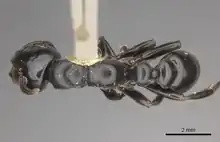Tetraponera aethiops
Tetraponera aethiops is a species of ant in the subfamily Pseudomyrmecinae, which is native to tropical Africa. It is found living in the forest in association with Barteria fistulosa, a small tree.
| Tetraponera aethiops | |
|---|---|
 | |
| Tetraponera aethiops, head | |
| Scientific classification | |
| Domain: | Eukaryota |
| Kingdom: | Animalia |
| Phylum: | Arthropoda |
| Class: | Insecta |
| Order: | Hymenoptera |
| Family: | Formicidae |
| Subfamily: | Pseudomyrmecinae |
| Tribe: | Pseudomyrmecini |
| Genus: | Tetraponera |
| Species: | T. aethiops |
| Binomial name | |
| Tetraponera aethiops Smith, 1877[1] | |
Distribution and habitat


This ant is always found living in association with the tree Barteria fistulosa, so the ant is only found where the tree grows in Central Africa. Its range extends from Nigeria, through Cameroon and the Central African Republic to the Democratic Republic of Congo. The tree grows in moist mixed terra firma forest where it forms part of the understory.[2][1]
Ecology
After her nuptial flight, a queen Tetraponera aethiops searches for a Barteria fistulosa tree. The branches are hollow and she chooses a shoot some 10 to 20 cm (4 to 8 in) long and chews a hole through which she enters the cavity, known as a domitia. This links up to other parts of the tree and already contains the resources she needs, scale insects and fungus, on which she feeds. As the shoot grows, the colony expands to fill the newly available space.[3] The ants are aggressive and have a very painful sting. They protect the host tree from herbivorous insects that feed on leaves, and their presence on the tree give rise to its common name of "ant tree".[4] The worker ants detect vibrations when an insect lands on a leaf blade, and rush out of their domitia to ambush it. A large insect may be stung by several ants, spread-eagled and cut in pieces; some ants may feed on the hemolymph while others may carry off bits of prey. Other victims like small caterpillars may be stung to kill them and discarded.[5]
References
- "Tetraponera aethiops". AntWeb. Retrieved 30 April 2020.
- "Barteria fistulosa". An introduction to the trees from the north of the Republic Congo. Royal Botanic Garden Edinburgh. Retrieved 30 April 2020.
- Brian, M.V. (2012). Social Insects: Ecology and Behavioural Biology. Springer Science & Business Media. pp. 82–83. ISBN 978-94-009-5915-6.
- Quattrocchi, Umberto (2016). CRC World Dictionary of Medicinal and Poisonous Plants: Common Names, Scientific Names, Eponyms, Synonyms, and Etymology. CRC Press. p. 543. ISBN 978-1-4822-5064-0.
- Dejean, Alain; Djieto-Lordon, Champlain; Orivel, Jerome (2008). "The plant ant Tetraponera aethiops (Pseudomyrmecinae) protects its host myrmecophyte Barteria fistulosa (Passifloraceae) through aggressiveness and predation". Biological Journal of the Linnean Society. 93 (1): 63–69. doi:10.1111/j.1095-8312.2007.00927.x.